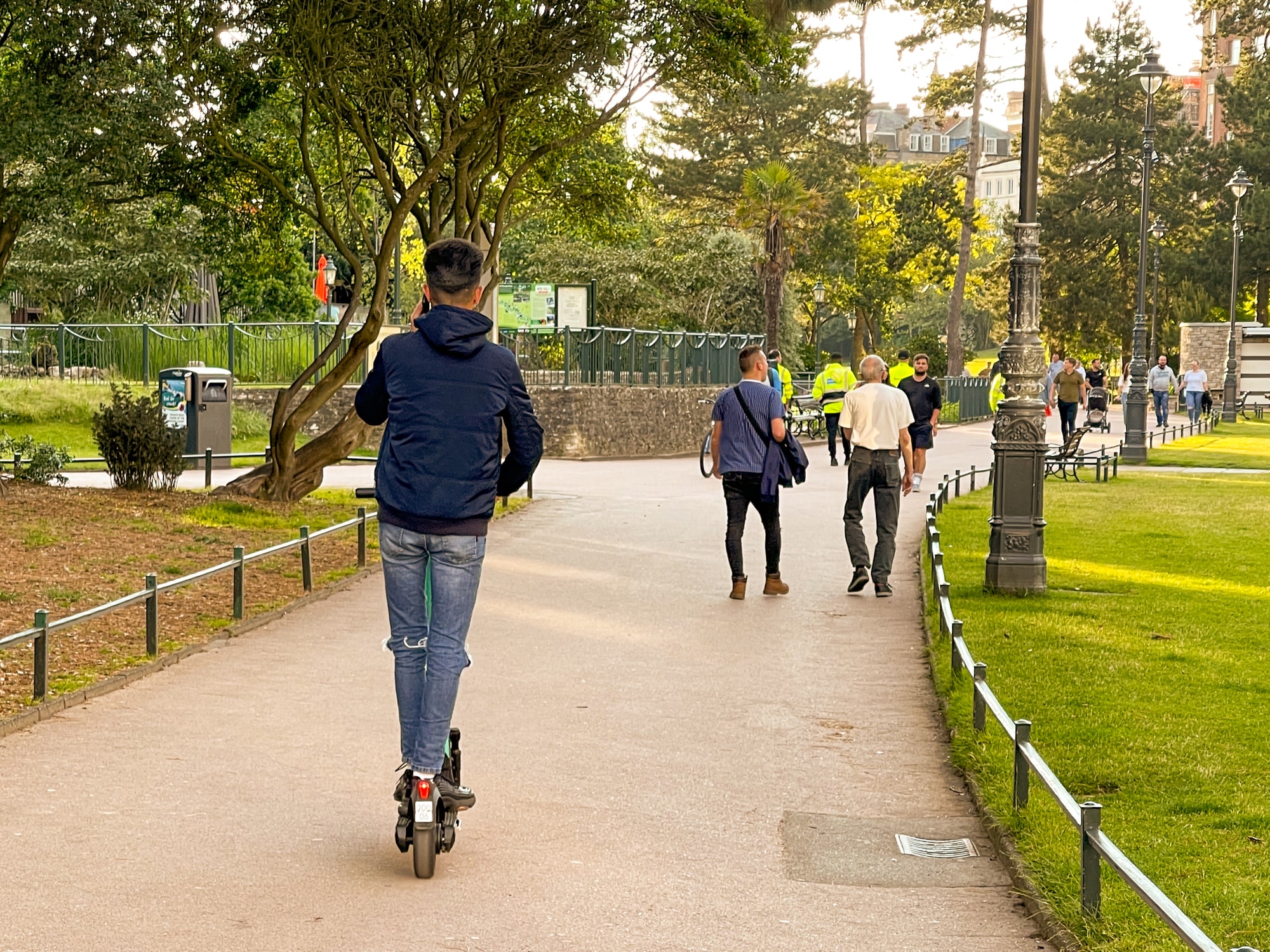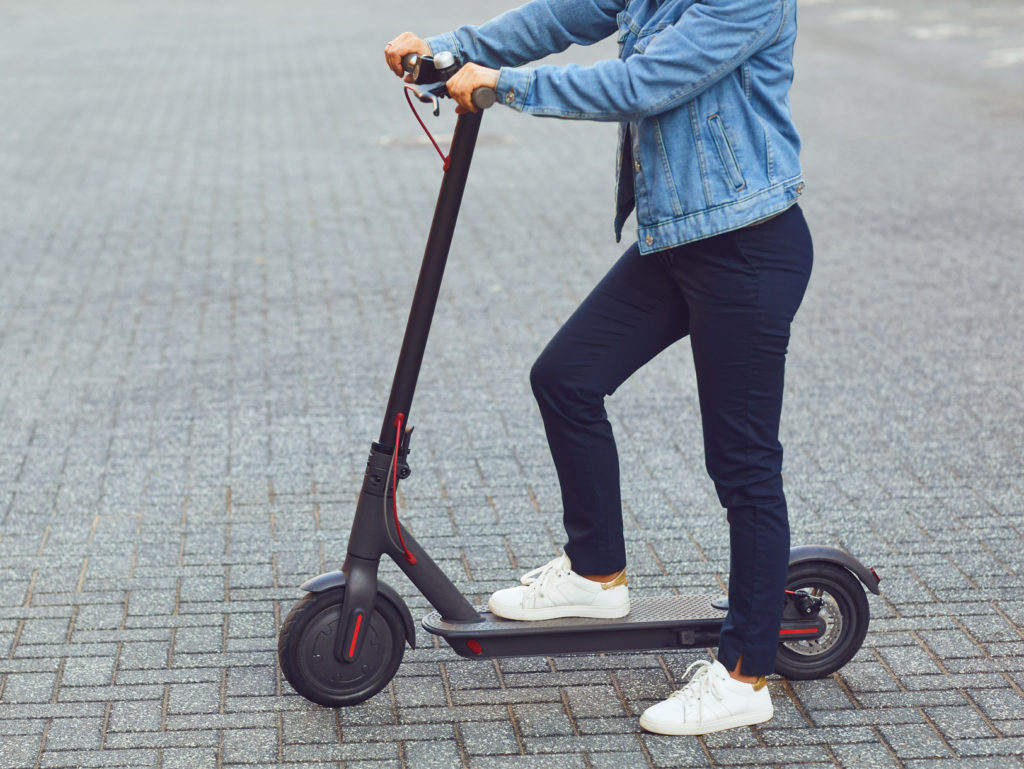Table of Contents
The electric scooter controller is one of the major components of an e-scooter.
Have you ever wondered how an electric scooter controls its speed even when receiving a constant power supply?
Unlike in internal combustion engines, where the automobile’s speed is controlled by increasing or reducing the amount of fuel entering the combustion chamber, electric scooters leverage electric controllers to regulate the speed.
The controller, also referred to as an electronic speed controller (ESC), is essentially an electronic circuit that regulates the speed of the motor in an E-scooter.
It directs and regulates power from the battery to the motor.
By twisting or pressing the throttle to a certain degree, a rider is principally sending signals to the controller, which signals the battery to release more or cut the amount of power being directed to the motor.
And if you press the electronic brakes, the controllers cut the power supply from the battery to the motor, causing it to stop functioning and ultimately reduce the overall speed.
While they are one of the most under-appreciated parts of an electric scooter, controllers are like the brain of e-scooters.
It links all other electronic components of the e-scooter, including the battery, motor, electronic brakes, throttle (accelerator), display (speedometer), speed sensors, and other components.
E-scooter controllers govern various aspects of the scooter, including starting, speeding, braking, riding modes, and ultimate stopping, among other functions.
Here is a detailed look at electric scooter speed controllers with an eye on their functioning in detail, types of controllers, maintaining and repairing controllers, as well as their overall importance.
What is an Electric Scooter Controller?

The importance of electric scooter controllers is to take all the inputs from all the electric components in the scooter, i.e. battery, throttle, speed sensor, display, motor, etc., and then determine the necessary signals that should be relayed to them.
For instance, when a rider twists or presses the throttle, it sends a signal to the controller, increasing the amount of current from the battery to the electric motor. More current to the motor means faster propulsion of the wheels hence more speed.
In most electric scooters, controllers have an electronic braking function.
When the rider presses down on the electronic brake levers, the controller cuts power to the motor. Additionally, others have a regenerative function where they route power back to the battery from the motor when the regen brake is activated.
They convert the kinetic energy harnessed from braking to electric energy, which is then channelled back from the motor to the battery for an even prolonged range. Almost all controllers in modern scooters have this feature.
E-scooter controllers are categorized based on motor type, functionality, and rating in terms of current and voltage.
Powerful scooters, especially those with dual electric motors, usually have two controllers with higher max current and voltage ratings but one throttle input.
Where is an Electric Scooter Controller Housed?
In e-scooters, the controller is usually placed in a metallic rectangular sealed protective box and mounted deep inside the frame, the electric scooter deck or stem.
The metallic enclosure comes in handy to facilitate heat conduction, allowing the components of the controller to function optimally.
E-scooter controllers can easily be noticed owing to the numerous wires and fuses of different colours emanating from the metallic enclosure.
How Do E-Scooter Controllers Work?
Electric scooter controller components can be categorized into two broad groups, i.e. main chips (microcontrollers) and peripheral components, i.e. MOSFET, sensors, resistors, etc.
They also encompass various electronic circuits, including power circuits, AD circuits, PWM generator circuits, power device driver circuits, over-current & under-voltage protection circuits, and signal acquisition and processing circuits, among other components.
The different components work in combination, governed by software integrated into the circuit board.
The functioning of the e-scooter controller is wholly dependent on the microcontroller, which acts as its brain. The microcontroller, also called the processor, receives several inputs, including control signals from various e-scooter components/sensors, including brake, throttle, and motor speed.
Once it receives a signal, the microcontroller, with the help of the software (firmware), analyzes the signal and determines the suitable output signal and its timing.
For instance, when you twist or press the throttle, the acceleration sensors signal the controller requesting it to increase the motor revolutions.
The microcontroller picks up this signal, interprets it, and stimulates the motor to revolve at a particular speed based on the signal. To do this, the microcontroller relays the signal to a setup of field-effect transistors (FETs), which function chiefly to drive the motor.
The FETs, which are the final recipient of the acceleration signal from the throttle, act as valves to regulate the flow of power from the battery to the motor and ultimately determine the final speed of the scooter.
The FETs are linked to the MOSFET drive circuit on the controller to rotate the motor and control its speed.
This circuit rapidly switches the FETs, producing the characteristic electric motor motion. The controller can make the motor spin faster or slower by fluctuating the duty cycle- the instances the FETs are on vs when they are off.
In addition to modulating the duty cycle of the FETs, the microcontroller is also responsible for modulating the timing of power delivery to the motor.
E-scooter motors contain electromagnets (poles) that can only be activated by precise power delivery based on the motor’s revs.
The controller constitutes a sensor that determines the exact speed of the motor, enabling the microcontroller to fluctuate the frequency of power delivery which in turn activates the electromagnetic poles in the motor.
The controller also supplies voltage to the various external scooter components via the power circuit.
The under-voltage circuit prevents the battery from discharging when the voltage is lower than the controller set value. In contrast, the over-current protection circuit limits the functioning of the battery, motor, and controller at a higher current, leading to damage of the e-scooter components.
Types of Electric Scooter Controllers
There are different e-scooter controllers based on the motor types, rating (voltage and current), and functionality. Below are the variations of e-scooter controllers:
Motor Type
Regarding motor types, e-scooter controllers are categorized into two major groups: Brushless DC motor controllers and Brushed DC motor controllers.
Brushless DC Motor Controllers
As the name implies, brushless DC motor controllers can be paired only with Brushless DC Motors (BLDC), i.e. motors with permanent magnets.
BLDC motor controllers are usually quite efficient, pretty reliable with enhanced efficiency. They typically have three phases with at least two transistors (MOSFET circuit) per phase.
Brushed DC motor controllers
These controllers are used in combination with brushed DC motors- motors with a collector and permanent magnets. They have a much simpler functionality compared to brushless DC motor controllers. So, they are primarily used in less powerful and less expensive e-scooters.
Rating
Electric scooter controllers (ESC) are usually rated in voltage and current.
Voltage
ESCs come in different voltages, including 24V, 36V, 48V, and 60V. 24 & 36-volt motor controllers are the most common in e-scooters.
A 24V ESC is compatible with 24 V brushless DC motors, which operate primarily between 150 -250 W. A 36 V ESC, on the other hand, is best paired with a 36 V brushless single electric motor with a 250-350 W rating and 18A as the current limit.
Take note that the controller’s voltage should always be similar to the motor’s voltage and that of the battery for optimal functionality of the different components.
Current
Generally, the controller current is smaller than the battery output current.
The current rating usually depends on the number of MOSFETs per phase. In this regard, a 6-MOSFET controller is rated 18A, a 9-MOSFET controller is rated 25A, a 12-MOSFET controller is rated 35A, and so on.
Functionality
When discussing functionality, BLDC controllers are the ones that are grouped further since they have a vast range of functions.
DC controllers have only one function: to regulate the amount of current supplied to the motor. As such, they can’t be categorized in regards to functionality.
Regarding functionality, BLDC controllers are grouped regarding whether they have Halls sensor, don’t have it, or whether they have dual-mode- can operate without or with Hall sensor.
BLDC controllers for motors with Hall sensors
Hall sensors are miniature devices that determine the position of the rotor (a rotating component of the motor) and stator (the fixed part of the motor).
Hall sensors, also referred to as rotary encoders, function based on the Hall Effect to establish the exact timing the rotor should be pushed forward or backwards to maintain the momentum of the motor.
The controller leverages Hall sensors to establish the corresponding amount of voltage that needs to be released to the motor based on its rotation. BLDC controllers for motors with Hall sensors are usually preferred as they are more stable, have a bigger start torque, and consume lower power.
Dual Mode BLDC Controllers
Some BLDC controllers can operate both with a Hall sensor and without it. They are referred to as dual-mode controllers.
Programmable Controllers
Some controllers can be programmed to achieve different possibilities such as setting or removing a speed limit, adjusting different riding modes, adjusting gradeability and acceleration by increasing amps. You can also increase the voltage to improve speed and enhance acceleration.
Some e-scooters such as Ninebot Max and Xiaomi M365 allow the software integrated into the controller to be updated remotely via Bluetooth.
This allows the manufacturer to release new software updates via the accompanying app for improved performance.
With programmable controllers, you can reverse engineer the software, flash it out and install your own firmware to customise the scooter’s performance to meet your intended need.
For instance, you can increase the top speed, power, and overall performance. However, you’ll want to consider this decision since such upgrades can reduce the scooter’s overall range, not to mention its lifespan.

Importance of E-Scooter Controllers
Controllers play a significant role in portable electric vehicles like electric bicycles (electric bike controllers) and e-scooters (ESC). They are basically like the brain or heart of the e-bike or e scooter.
They take input signals from various components such as the battery, display, motor, throttle, speed sensor, etc., and then analyze the signals with the help of firmware and implement the appropriate action.
Some benefits of e-scooter controllers include:
- E-scooter controllers facilitate communication between the motor, battery, and the other components in the scooter. With proper communication, every component in the scooter will function in unison and harmony for the ultimate goal, which is to propel the rider safely.
- E-scooter controllers play a significant role in starting a scooter. It feeds the needed amount of electricity to the AC/DC brushless motor causing the scooter to power up. They also recognize the minimum speed required to power on a kick-start e scooter and resultantly engage the power to the motor.
- Controllers are essential in controlling the speed of e-scooters. It does this by regulating the amount of power reaching the motor in relation to the position of the throttle.
- ESCs protect the scooter’s components in case of a malfunction in the power drain system or motor. E-scooter controllers are fitted with multiple protection functions, including:
- Over-voltage protection – Monitors the battery voltage and shuts down the monitor when the battery voltage surpasses the optimum level. This, in turn, safeguards the battery from overcharging.
- Low–voltage protection– The controller monitors the battery voltage and prevents the battery from discharging when the voltage dips below minimum.
- Over–temperature protection– This component monitors the temperature of the field-effect transistor (FET) and shuts down the monitor in case it becomes extremely hot. This is vital to protect the FET power transistors since they are susceptible to malfunctioning due to high temperatures.
- Over–current protection– This feature protects both the FET power transistors and motor in case of an oversupply of current.
- Brake protection– ESCs are fitted with the brake protection feature to shut down the motor when the rider brakes. Brake protection overrides other signals, including throttle to slow down or stop the scooter.
- In scooters with regenerative braking, the controllers convert the kinetic energy to heat energy and ultimately electric energy. They then channel the electric energy to the battery for storage, in turn prolonging the range.
Replacing an E-Scooter Controller
Sometimes, an electric scooter controller may be damaged due to various issues such as overheating, short circuits, etc.
In such circumstances, it would be prudent to replace the entire controller rather than wasting your precious time trying to repair it. E-scooter controllers are mass-produced therefore are readily available with prices ranging from £15- £40 for cheap ones and £145-£350 for higher quality ones.
When looking to replace your damaged ESC, there are several aspects you ought to understand, as detailed below.
Choosing an E-scooter Controller
When choosing an ESC to replace your damaged electric scooter controller, the first important point to note is that the controller should have similar ratings (voltage and current) as the scooter’s motor and battery.
If the controller is programmable, it may have slightly more power than the motor and battery since the ratings can be customised to match those of the motor and battery.
If you purchase a non-programmable controller, please ensure that its current and voltage are matched with the motor’s power and voltage. If the motor’s rating is 36V, 4Ah, then the controller should have a similar rating.
This will ensure that the controller operates stably and reliably without issues such as overheating.
Regarding the rating, you also need to understand the difference between phase and battery currents. Phase current is the final output to the motor, while battery current is the current from the battery.
When buying an ESC, you need to ensure that the phase current and the motor current match to avoid overheating the motor leading to short circuits and malfunctions.
Also, if you don’t have hands-on experience in electrical components, you’ll want to buy the complete package, i.e. motor and controller. Or you may want to seek help from experts to replace your e-scooter controller safely.
You also need to consider the factors below.
Square vs Sine Wave Controllers
E-scooter controllers are differentiated into two motor-phase groups based on the phase voltage waveform- square wave and sine wave controllers. Square wave controllers produce trapezoidal (square) waves while sine wave controllers produce sinusoidal waves, which appear smoother.
While they have some differences, it isn’t easy to pinpoint the better one considering that the optimal waveform depends on the scooter’s wheel. Besides, both have their fair share of advantages and disadvantages, as outlined below.
Sine Wave Controllers
Pros
- Produce lower noise
- They have a smoother and more reliable control of all components in the scooter.
- Sine wave controllers have more climbing power and are more efficient when carrying a heavy load.
Cons
- A bit expensive
- Consumes more power
- Compatible with only the matched motors
Square Wave Controllers
Pros
- Compatible with different motors
- Not expensive
- Utilize more power voltage
- Highly efficient in braking and sudden acceleration
Cons
- Produce a lot of noise
- Voltage sag when the scooter hits high speed or acceleration
- Lower efficiency in handling heavy loads and climbing steep roads
- The control is neither smooth nor linear. It may be punched at times
After going through the benefits and downsides of both controllers, you can now choose an ideal one based on your specific needs.

How to Connect an E-scooter Controller?
In case you’ve bought a new controller for your electric scooter and would like to connect it, follow this guide. The colours differentiate the wire types, their terminals, and their respective components.
Here’s how different components connect to the controller.
Battery – The red and black cable connects to the battery. The black cable connects to the negative terminal, while the red cable connects to the battery’s positive terminal.
Scooter motor– The scooter motor is connected by three green, yellow, and blue cables.
Hall sensor– A five-pin connector consisting of five different cables, i.e. blue, green, red, black, yellow, connects to the hall sensor.
Throttle– The accelerator is linked to the controller with a three-pin connector consisting of three black, green, and red cables. However, the pin connector varies by model.
Key switch cables– Linked by the white and red cables.
Brake– Connected with black and purple cables
Speedometer (display) – Green and yellow wires connect the speedometer on the display
Cruise Control- Linked to the controller by black and orange wires.
Tips for Diagnosing a Faulty Controller
If you think your e-scooter controller isn’t working correctly, you need to check out a few things to establish whether it’s damaged. You need to:
- Check whether the connector is in switch-on condition.
- Inspect whether the fuse is functional. Sometimes, the fuse may blow out to prevent overheating caused by over-voltage or over-current supply.
- Ensure that all components connecting to the speed controller are functional. If all are functional, the problem is definitely with the controller.
- Take a deeper look at the motor. If any is damaged, then the problem lies with the controller.
- Use a multimeter to test the throttle.
- Charge the battery for the recommended maximum charge time and see if the controllers on your electric scooter work.
Final Thoughts
An e-scooter controller is a crucial component in a scooter.
Without it, an electric scooter is barely functional. The controller is the equivalent of the brain in human beings. It essentially facilitates communication between all the components of an e-scooter, including the motor, battery, throttle, headlight, display (speedometer), etc.
The controller gathers all the input signals from the core electric components, analyzes the signal with the help of firmware, and determines an appropriate action in return.
The controller is genuinely one of the most crucial components by performing vital functions such as starting the motor, regulating the scooter’s speed, recycling energy in regenerative braking, and safeguarding the scooter’s components in case of a malfunction in an e-scooter.
When buying a controller, maybe to replace a damaged one, always ensure the controller’s and motor’s ratings are the same. You should also be keen not to confuse battery and phase currents.
It’s best to trust experts, especially if you lack sufficient experience dealing with electronics.

